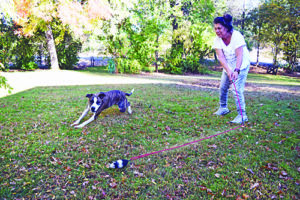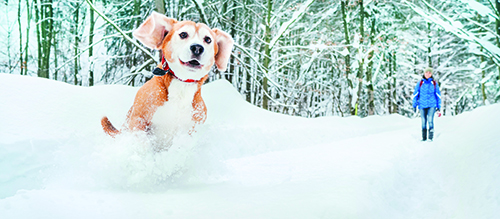It can be very challenging to keep your canine family members happy during the ravages of winter. Even those who live in the warmer southern states may face long stretches of forced idleness from winter rains. Without ample enrichment activities, weeks and months of short, dark days can turn even a calm canine into a hyper hound.
Fortunately, the ever-creative modern dog training world has come up with countless ways to keep our dogs happy in inclement weather, so that dogs and humans can spend more time snuggled together in front of the warm fireplace and less time worrying about frostbite or drowning (see “Winter Warnings,” next page).
KEEPING ACTIVE IN THE WINTER
One of the best ways to stave off your dog’s winter crazies is to provide her with a wide variety of enrichment activities. Some are easy and can be implemented immediately, while some take a little more investment in time and resources. Let’s start with easy:
Indoor Fetch. If there’s only one of you and your dog will fetch, you can stand at the top of the stairs and toss her ball or toy to the bottom, have her run down to get it, run back up to you. If she will chase it but not bring it back, have a laundry basket full of toys or balls, call her back, and just keep throwing new ones. When you have thrown them all, go down the stairs, collect them, and bring them back up. If you don’t have stairs (or she can’t do stairs) use a long hallway. Get added benefit by putting barriers across the hall for her to jump over as she runs back and forth.
Jump the Jumps. When I was a wee child, I used to take broomsticks and mop handles and lay them across chairs all around the house, and then run with my Rough Collie, Squire, as he sailed over my makeshift jumps. You can do the same! If you prefer, you can get sections of PVC pipe at a hardware store. Start with the poles on the ground and use a treat to get your dog to walk over them, then trot over them.
When she is ready for more, use poles to make low X-shaped jumps before you use straight poles to make higher jumps. (Note: Young puppies shouldn’t jump until they are old enough not to be harmed by the repeated impacts. Check with your vet to make sure jumping is a safe activity for your pup.)
Round Robin Recall. You need at least two humans and a dog who loves to come when she’s called for this game. The larger your house and the more humans (within reason!), the better.
Put Billy (B) on the third floor, Janey (J) on the second, Mom (M) on the ground floor, and Dad (D) in the basement. (If stairs are not safely carpeted or dog has trouble with stairs, put all humans in different rooms on the same floor.) Each human has yummy treats and a toy that the dog likes for reinforcement when the dog arrives. Write up a random calling order and give each person a copy to ensure two humans aren’t calling her at the same time, and let the fun begin.
Be sure each person has a fun party with the dog when she gets there! This not only burns off dog energy, it gives the kids something to do, and it helps improve your dog’s recall.
Ball Pit. For this one you need a kiddie wading pool and a generous supply of non-toxic, sturdy ball-pit balls. Put a towel down to cover the bottom of the pool (so the sound doesn’t startle your dog), fill the pool with balls (no water!), and let the fun begin! If your dog doesn’t take to it immediately, toss treats and favorite toys into the pool and let her – or help her – dig for them.
Snuffle Mat (and other food toys). Interactive food-dispensing toys are a simple solution to many dogs’ winter blues. We particularly like “snuffle mats,” where you bury treats in the cloth fingers of a textured mat and let your dog go to it. If you have a dog who wants to eat the mat or, in contrast, just isn’t interested, there are many other options, including treat-dispensing toys your dog pushes around, and puzzle toys she has to solve to get the treats. (See “Play with Your Food,” WDJ April 2019).
Flirt Pole. This is simply a sturdy pole with a rope fastened to one end and a toy fastened to the rope. You can make one or buy one. To play, stand in one place and swing the toy around for your dog to chase. (You can also practice “Trade” to get the toy back once your dog has grabbed it; see “Trade Agreements,” WDJ February 2017).

If your dog tends to bodyslam you (or your kids) while playing this game, stand inside an exercise pen for protection while your dog chases the toy around the outside of the pen.
These toys are available in better pet supply stores and from online sources such as Chewy.com and Amazon.com. Outward Hound makes one called the “Tail Teaser” and sells it with an extra replacement toy for about $13; Chewy.com also sells one called the Pet Fit for Life Plush Wand Teaser Dog Toy for $11.
Nose Games. Scent work is surprisingly tiring, and because most dogs love to sniff, it’s also very satisfying for them. It’s also usually an easy game to teach. Have your dog sit and wait (or have someone hold her collar). Hold up a treat, walk six feet away, and place it on the floor. Return to your dog, pause, and then say “Search!” Encourage her to run out and eat the treat.
After a few repetitions, let her watch you “hide” the treat in an easy spot (on the floor behind a chair leg, etc.). Return and tell her “Search!” Gradually hide the treat in harder places, then multiple treats, and eventually have her in another room while you hide treats. This should keep her quite busy and tire her out nicely. (For much more information, see “How to Teach Your Dog to Play Nose Games,” WDJ September 2019.)
Treadmill. Now we’re getting into activities that require more investments in time and resources. First, of course, you need a treadmill. Be sure to get one that is safe to use with dogs. Dog-specific treadmills generally are smaller than human products (some are made just for small dogs!) and have appropriately sized siderails (for safety, to keep the dog from falling off on the sides).
You will need to do a very gradual introduction, associating the machine with treats and toys until your dog is very comfortable being near it, and then on it, before you even think of turning it on. Be sure not to overdo the exercise; check with your veterinarian about how much exercise is appropriate for your dog to start with and how you should increase the time (gradually!).
Cognition Training. Those winter shut-in months are a perfect time to experiment with cognition training for your dog. You don’t need a lot of room, and this brain exercise is surprisingly tiring. You can teach your dog to imitate your specific behaviors (see “Copy That,” October 2013); explore choice (see “Pro-Choice,” November 2016); learn to demonstrate object, shape, and color discrimination and even read! (see “Are Canines Cognitive?” October 2017), and much more.
Indoor Parkour. If you really want to get creative, you can set up an indoor parkour course for your dog, made out of household items. After you’ve taught your dog each of the various obstacles, put them all together into a complete course. Here are some suggestions for obstacles that you can train your dog to navigate:
- Laundry Leap: Get a laundry basket that’s an appropriate size for your dog, and teach him to jump into and out of it.
- Hoop-De-Do: Best use of a hula hoop ever! Hold it up for your dog to jump through, or wedge it between a chair and a wall for a fixed jump.
- Sweet Roll: Roll up a carpet runner and let your dog unroll it with her nose. (Teach this one by placing treats inside the rug as you roll it so she finds them as she unrolls it.) This would be especially fun if you had a red carpet that your dog could unroll for special guests!
- That Was Easy: A smack of the paw lets your dog share her editorial opinion. These buttons are available from Staples stores and its website – or you can find a variety of wonderful talking buttons at this online site: speaktomecatalog.com (select “buttons”).
- Go ’Round: A simple orange traffic cone makes a perfect loop-stacle to send your dog around the bend in a different direction.
- Walk the Plank: Place an eight-foot long 2×8 board across two low stools and let your dog walk the plank! Increase the level of difficulty with narrower planks.
- Tunnel o’ Chairs: If you have a smaller dog, start by teaching her to crawl under one folding chair, then add a second chair, then a third, eventually making your crawl tunnel as long as you want it to be!
Whatever your fancy, there should be some activities here that you and your dog can enjoy together when the weather outside is frightful. Stay warm, stay safe, and have fun!







Definitely great activities that dogs will gonna love. Nice post!
What about just gearing up and hiking in the rain? My German Shorthaired Pointer
insisted in getting her usual walks regardless of the weather, so years ago I invested in a good rain suit and boots for me. I got a RuffWear Cloud Chaser waterproof suit for her, fits like a snug shirt and keeps her body dry. Rain walks are awesome, no one out but us and the newts!
Some very creative ideas here. Will try them. Thanks!
Thanks Fleck’s Ma for the rain suit hint..will certainly invest in one for me and my fur child!
Great indoor activities for when it is too hot for a double coated dog
Yes, I’m saving these suggestions for summer when my dogs are crazy inside but don’t want to move outside. 🙂
super! WOuld also like more mind games. My active Aussie puppy appreciates you!
I was expecting some suggestions for outdoor activities. Winter hiking and walks? Kicksledding? Fat bike-joring? Skijoring?
What are those things